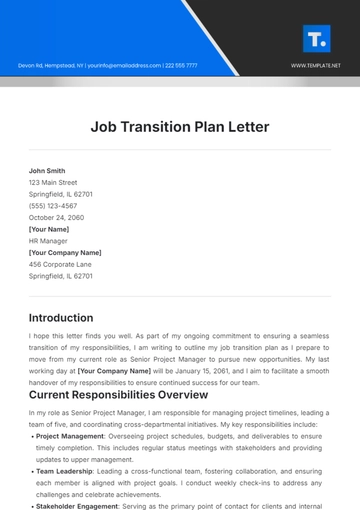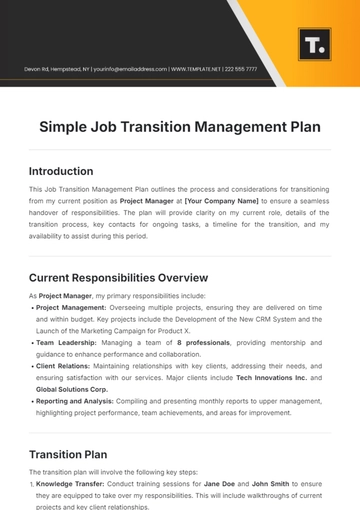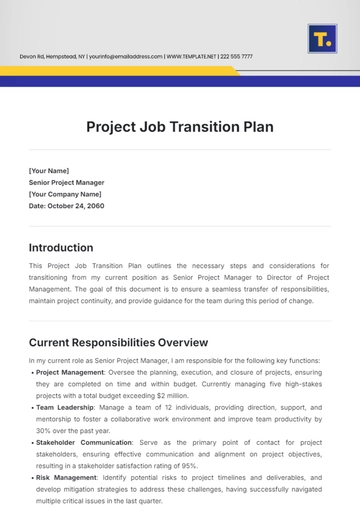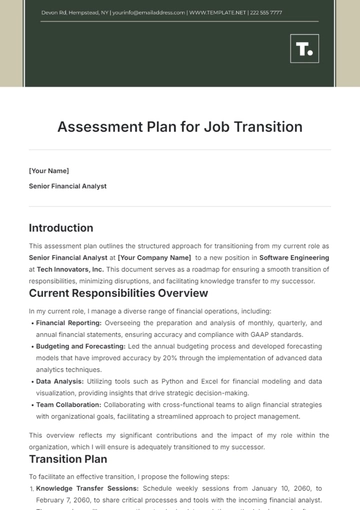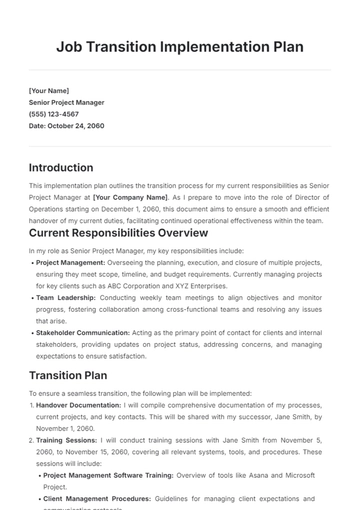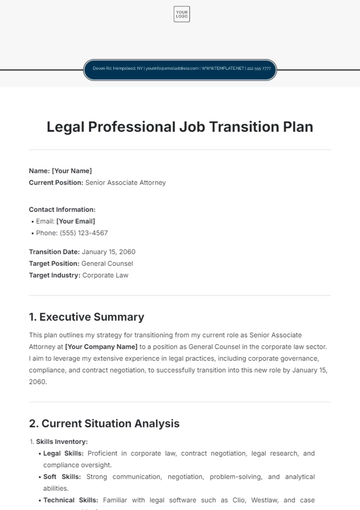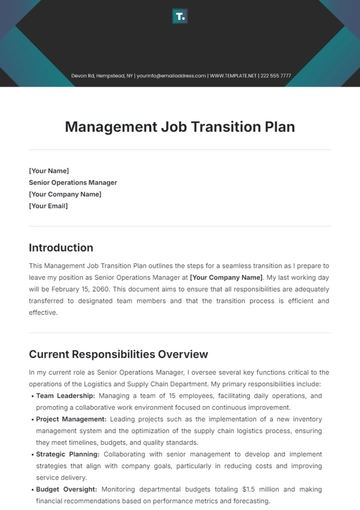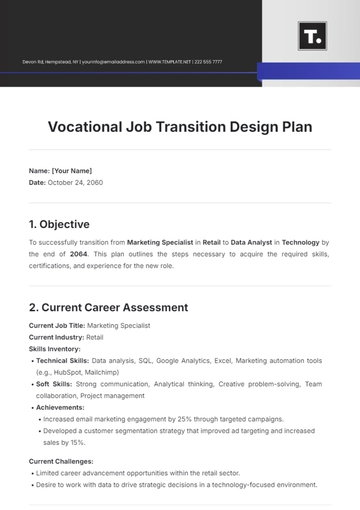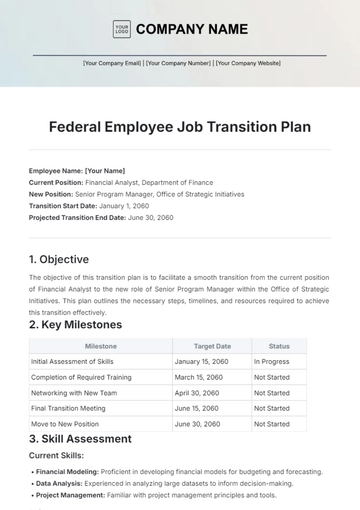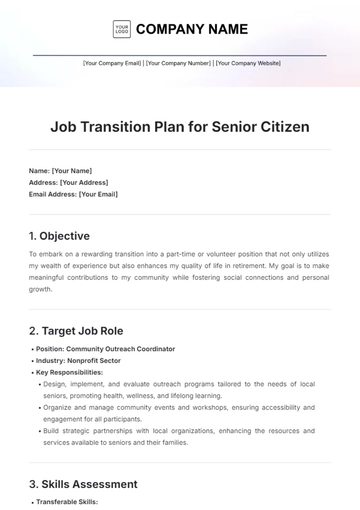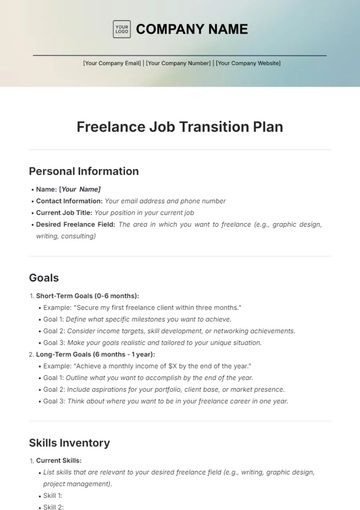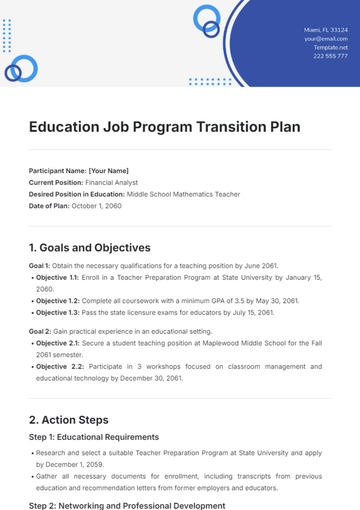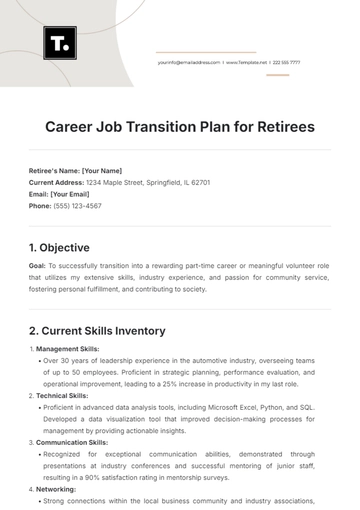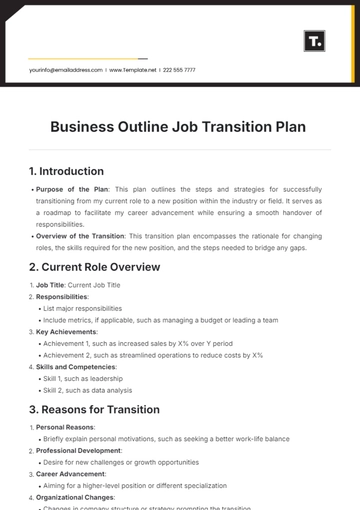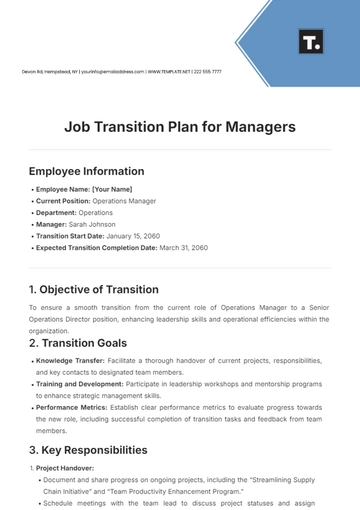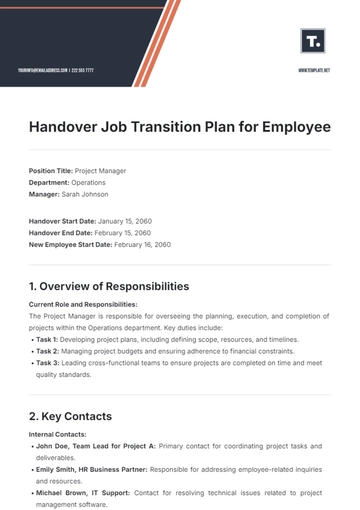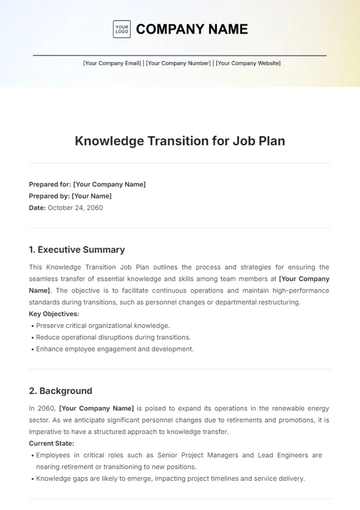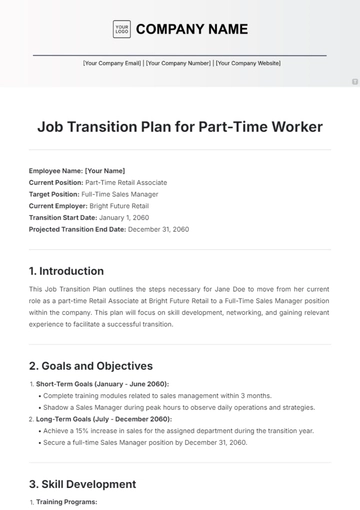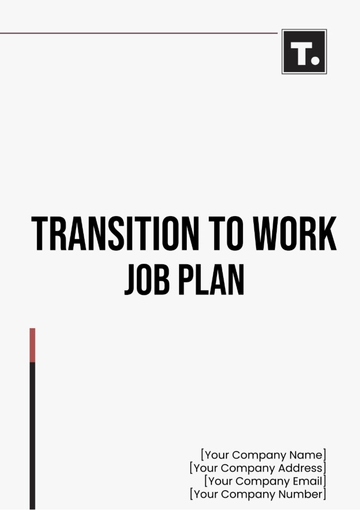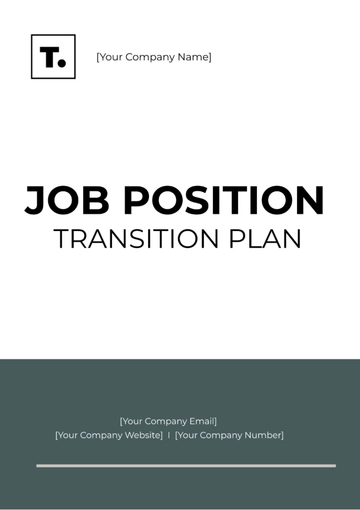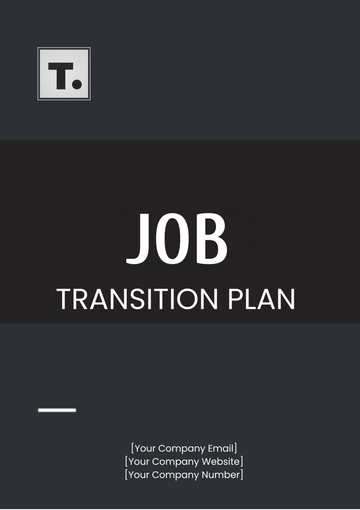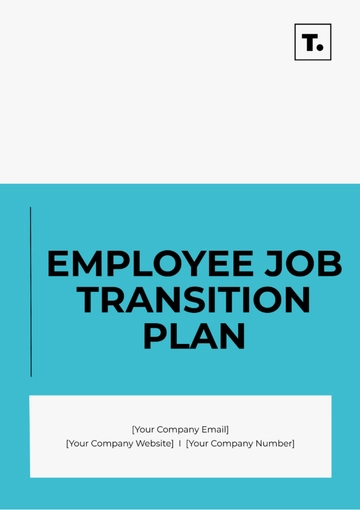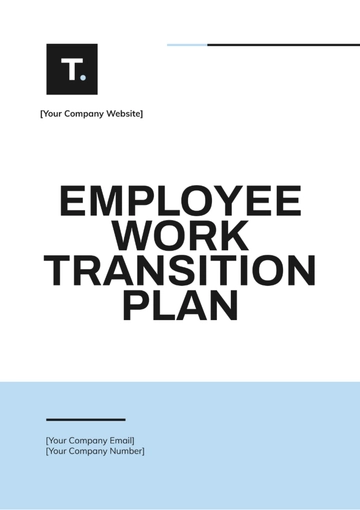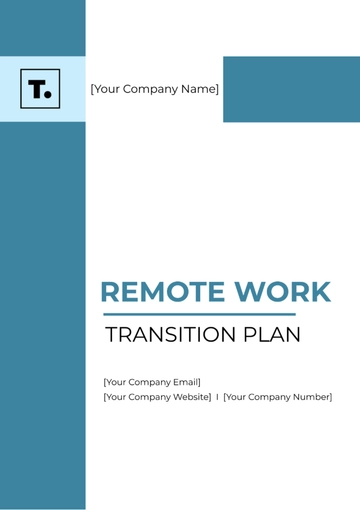Free Employee Job Transition Plan

Prepared By : | [YOUR NAME] |
Email: | [YOUR EMAIL] |
Date: | [DATE] |
I. Introduction
The Employee Job Transition Plan serves as a comprehensive framework to facilitate smooth transitions for employees moving between roles within our organization. In alignment with our organizational values of adaptability and growth, this plan aims to provide structured guidance, training, and support to ensure the success of transitioned employees. By prioritizing their development and well-being, we aim to foster a culture of continuous improvement and enhance organizational effectiveness.
II. Objectives
Seamless Transition: Our foremost objective is to ensure a seamless transition process for employees, minimizing disruptions to workflow and maintaining operational efficiency.
Skill Enhancement: We are committed to providing opportunities for skill enhancement and development to empower employees to excel in their new roles and contribute effectively to the organization's goals.
Employee Support: Comprehensive support mechanisms will be established to address any concerns or challenges that employees may face during the transition, fostering a supportive environment conducive to success.
Maintaining Productivity: It is essential to maintain or even enhance productivity levels throughout the transition period to sustain business operations and meet performance targets.
Career Growth: Facilitating opportunities for career growth and advancement within the organization is a key objective to retain top talent, promote loyalty, and nurture future leaders.
III. Transition Process
Identification of Transitioning Employees: HR will collaborate closely with department heads to identify employees undergoing role transitions, ensuring timely and accurate documentation of transition needs.
Needs Assessment: A comprehensive needs assessment will be conducted for each transitioning employee, encompassing evaluations of skills, knowledge, and competencies required for the new role.
Training and Development: Customized training plans will be developed for transitioning employees, incorporating a blend of on-the-job training, workshops, and specialized courses tailored to individual learning styles and preferences.
Support Mechanisms: Dedicated transition mentors will be assigned to provide personalized guidance and support, supplemented by peer support groups, and regular check-ins with managers to monitor progress and address any concerns promptly.
Performance Monitoring: Performance metrics will be established and closely monitored during the transition period to track progress, identify areas for improvement, and provide targeted interventions as needed.
Feedback and Evaluation: Ongoing feedback mechanisms will be implemented to gather input from transitioning employees, enabling continuous evaluation and refinement of the transition process to optimize outcomes.
IV. Communication Plan
Announcement: A formal announcement will be made to all employees to introduce the transition plan, emphasizing transparency, and providing an overview of the process, objectives, and support resources available.
Individual Meetings: Transitioning employees will be scheduled for individual meetings with HR representatives to discuss their transition plans, clarify expectations, and address any questions or concerns they may have.
Regular Updates: Regular communications will be issued to transitioning employees, providing updates on training schedules, support resources, and key milestones to keep them informed and engaged throughout the transition process.
Open-door Policy: An open-door policy will be maintained to encourage employees to seek guidance or clarification from HR or management at any stage of the transition process, ensuring accessibility and responsiveness to their needs.
V. Timeline
Transition Timeline
Stage | Duration | Expected Completion Date |
|---|---|---|
Needs Assessment | 2 weeks | January 10, 2050 |
Training and Development | 6 weeks | February 24, 2050 |
Performance Monitoring | Ongoing | March 31, 2050 |
Evaluation and Feedback | 1 week | April 14, 2050 |
VI. Resources
Training Materials: Access to a comprehensive range of training materials, including manuals, online courses, and interactive modules, will be provided through our learning management system, ensuring accessibility and flexibility for transitioning employees.
Support Personnel: Transition mentors will be carefully selected from experienced employees within the organization and will undergo specialized training to equip them with the necessary skills and knowledge to effectively support transitioning employees.
Financial Assistance: Budget allocations will be made available for training programs, certifications, or other educational opportunities required for the transition, ensuring equitable access to development resources for all transitioning employees.
VII. Evaluation and Feedback
Metric | Feedback Mechanism |
|---|---|
Employee Satisfaction | Surveys, Focus Groups |
Performance Evaluation | Manager Assessments |
Process Improvement | Feedback Forms, Suggestions Box |
VIII. Conclusion
The Employee Job Transition Plan embodies our commitment to supporting employees through career transitions and fostering a culture of continuous learning and development. By implementing structured processes and providing robust support, we aim to ensure the success and satisfaction of transitioning employees, thereby contributing to the long-term success and sustainability of our organization.
- 100% Customizable, free editor
- Access 1 Million+ Templates, photo’s & graphics
- Download or share as a template
- Click and replace photos, graphics, text, backgrounds
- Resize, crop, AI write & more
- Access advanced editor
Ensure smooth job changes with the Employee Job Transition Plan Template from Template.net. This customizable and editable template offers a structured approach to managing role transitions. Easily tailor it to your specific needs using our intuitive Ai Editor Tool. Enhance productivity, maintain continuity, and facilitate seamless transitions with this essential tool from Template.net. Simplify job changes today.
You may also like
- Finance Plan
- Construction Plan
- Sales Plan
- Development Plan
- Career Plan
- Budget Plan
- HR Plan
- Education Plan
- Transition Plan
- Work Plan
- Training Plan
- Communication Plan
- Operation Plan
- Health And Safety Plan
- Strategy Plan
- Professional Development Plan
- Advertising Plan
- Risk Management Plan
- Restaurant Plan
- School Plan
- Nursing Home Patient Care Plan
- Nursing Care Plan
- Plan Event
- Startup Plan
- Social Media Plan
- Staffing Plan
- Annual Plan
- Content Plan
- Payment Plan
- Implementation Plan
- Hotel Plan
- Workout Plan
- Accounting Plan
- Campaign Plan
- Essay Plan
- 30 60 90 Day Plan
- Research Plan
- Recruitment Plan
- 90 Day Plan
- Quarterly Plan
- Emergency Plan
- 5 Year Plan
- Gym Plan
- Personal Plan
- IT and Software Plan
- Treatment Plan
- Real Estate Plan
- Law Firm Plan
- Healthcare Plan
- Improvement Plan
- Media Plan
- 5 Year Business Plan
- Learning Plan
- Marketing Campaign Plan
- Travel Agency Plan
- Cleaning Services Plan
- Interior Design Plan
- Performance Plan
- PR Plan
- Birth Plan
- Life Plan
- SEO Plan
- Disaster Recovery Plan
- Continuity Plan
- Launch Plan
- Legal Plan
- Behavior Plan
- Performance Improvement Plan
- Salon Plan
- Security Plan
- Security Management Plan
- Employee Development Plan
- Quality Plan
- Service Improvement Plan
- Growth Plan
- Incident Response Plan
- Basketball Plan
- Emergency Action Plan
- Product Launch Plan
- Spa Plan
- Employee Training Plan
- Data Analysis Plan
- Employee Action Plan
- Territory Plan
- Audit Plan
- Classroom Plan
- Activity Plan
- Parenting Plan
- Care Plan
- Project Execution Plan
- Exercise Plan
- Internship Plan
- Software Development Plan
- Continuous Improvement Plan
- Leave Plan
- 90 Day Sales Plan
- Advertising Agency Plan
- Employee Transition Plan
- Smart Action Plan
- Workplace Safety Plan
- Behavior Change Plan
- Contingency Plan
- Continuity of Operations Plan
- Health Plan
- Quality Control Plan
- Self Plan
- Sports Development Plan
- Change Management Plan
- Ecommerce Plan
- Personal Financial Plan
- Process Improvement Plan
- 30-60-90 Day Sales Plan
- Crisis Management Plan
- Engagement Plan
- Execution Plan
- Pandemic Plan
- Quality Assurance Plan
- Service Continuity Plan
- Agile Project Plan
- Fundraising Plan
- Job Transition Plan
- Asset Maintenance Plan
- Maintenance Plan
- Software Test Plan
- Staff Training and Development Plan
- 3 Year Plan
- Brand Activation Plan
- Release Plan
- Resource Plan
- Risk Mitigation Plan
- Teacher Plan
- 30 60 90 Day Plan for New Manager
- Food Safety Plan
- Food Truck Plan
- Hiring Plan
- Quality Management Plan
- Wellness Plan
- Behavior Intervention Plan
- Bonus Plan
- Investment Plan
- Maternity Leave Plan
- Pandemic Response Plan
- Succession Planning
- Coaching Plan
- Configuration Management Plan
- Remote Work Plan
- Self Care Plan
- Teaching Plan
- 100-Day Plan
- HACCP Plan
- Student Plan
- Sustainability Plan
- 30 60 90 Day Plan for Interview
- Access Plan
- Site Specific Safety Plan
